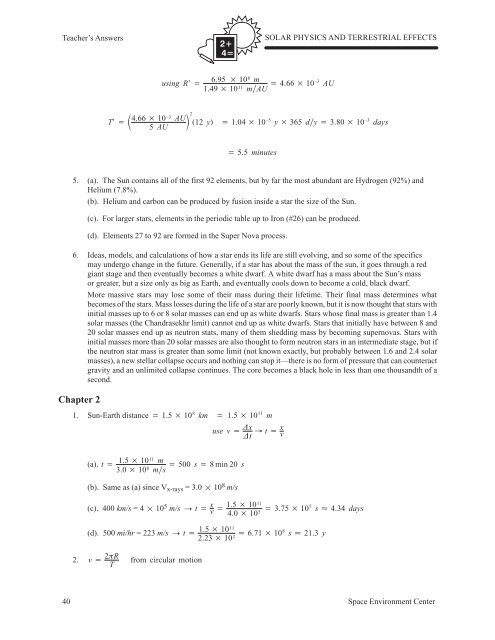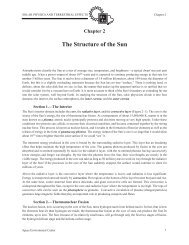Answers to Chapter Questions - Space Environment Center
Answers to Chapter Questions - Space Environment Center
Answers to Chapter Questions - Space Environment Center
Create successful ePaper yourself
Turn your PDF publications into a flip-book with our unique Google optimized e-Paper software.
Teacher’s <strong>Answers</strong><br />
<br />
<br />
SOLAR PHYSICS AND TERRESTRIAL EFFECTS<br />
using R <br />
6.95 108 m<br />
1.49 10 11 mAU 4.66 10–3 AU<br />
T 4.66 10–3 AU<br />
5 AU<br />
2 (12 y) 1.04 10 –5 y 365 dy 3.80 10 –3 days<br />
5.5 minutes<br />
5. (a). The Sun contains all of the first 92 elements, but by far the most abundant are Hydrogen (92%) and<br />
Helium (7.8%).<br />
(b). Helium and carbon can be produced by fusion inside a star the size of the Sun.<br />
(c). For larger stars, elements in the periodic table up <strong>to</strong> Iron (#26) can be produced.<br />
(d). Elements 27 <strong>to</strong> 92 are formed in the Super Nova process.<br />
6. Ideas, models, and calculations of how a star ends its life are still evolving, and so some of the specifics<br />
may undergo change in the future. Generally, if a star has about the mass of the sun, it goes through a red<br />
giant stage and then eventually becomes a white dwarf. A white dwarf has a mass about the Sun’s mass<br />
or greater, but a size only as big as Earth, and eventually cools down <strong>to</strong> become a cold, black dwarf.<br />
More massive stars may lose some of their mass during their lifetime. Their final mass determines what<br />
becomes of the stars. Mass losses during the life of a star are poorly known, but it is now thought that stars with<br />
initial masses up <strong>to</strong> 6 or 8 solar masses can end up as white dwarfs. Stars whose final mass is greater than 1.4<br />
solar masses (the Chandrasekhr limit) cannot end up as white dwarfs. Stars that initially have between 8 and<br />
20 solar masses end up as neutron stats, many of them shedding mass by becoming supernovas. Stars with<br />
initial masses more than 20 solar masses are also thought <strong>to</strong> form neutron stars in an intermediate stage, but if<br />
the neutron star mass is greater than some limit (not known exactly, but probably between 1.6 and 2.4 solar<br />
masses), a new stellar collapse occurs and nothing can s<strong>to</strong>p it—there is no form of pressure that can counteract<br />
gravity and an unlimited collapse continues. The core becomes a black hole in less than one thousandth of a<br />
second.<br />
<strong>Chapter</strong> 2<br />
1. Sun-Earth distance 1.5 10 8 km 1.5 10 11 m<br />
use v x<br />
t t x v<br />
(a). t 1.5 1011 m<br />
500 s 8 min 20 s<br />
3.0 10 8 ms<br />
(b). Same as (a) since V x-rays = 3.0 10 8 m/s<br />
(c). 400 km/s = 4 10 5 m/s t x v<br />
(d). 500 mi/hr = 223 m/s t <br />
<br />
1.5 1011<br />
4.0 10 5 3.75 105 s 4.34 days<br />
1.5 1011<br />
2.23 10 2 6.71 108 s 21.3 y<br />
2. v 2R<br />
T<br />
from circular motion<br />
40 <strong>Space</strong> <strong>Environment</strong> <strong>Center</strong>



